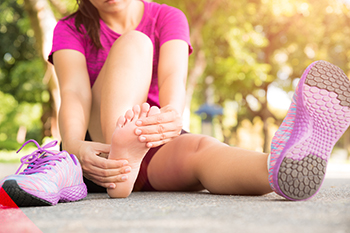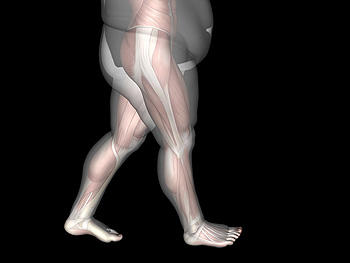Connect With Us
Blog
Items filtered by date: May 2023
Various Reasons Toe Pain Can Require Different Treatments

Toe pain is very uncomfortable and can happen for a variety of reasons, including the arthritic condition that is known as gout, or medical reasons such as bunions and hammertoes. Many people can experience toe pain from wearing shoes that do not fit correctly, or if the toe is stubbed against a piece of furniture. The latter reason may result in a broken toe, and it is often difficult to walk. Despite the reason for toe pain, mild relief may be found when the foot is elevated, and weight is kept off it. Treatment can vary, and this depends on the reason for the toe pain. If the toe is broken, the buddy taping method may be effective in keeping the injured toe stable by taping it to the toe next to it. The majority of people that have toe pain choose to wear shoes that may be a bit larger, and this may help to accommodate the injured toe. If you have toe pain, it is strongly suggested that you are under the care of a podiatrist who can determine what the cause is, and offer you correct treatment solutions.
Toe pain can disrupt your daily activities. If you have any concerns, contact Jeffrey Rosenblatt, DPM of New York. Our doctor can provide the care you need to keep you pain-free and on your feet.
What Causes Toe Pain?
Most severe toe pain is caused due to a sports injury, trauma from dropping something heavy on the toe, or bumping into something rigid. Other problems can develop over time for various reasons.
Toe pain can be caused by one or more ailments. The most common include:
- Trauma
- Sports injury
- Wearing shoes that are too tight
- Arthritis
- Gout
- Corns and calluses
- Hammertoe
- Bunions
- Blisters
- Ingrown toenails
- Sprains
- Fractures (broken bones)
- Dislocations
When to See a Podiatrist
- Severe pain
- Persistent pain that lasts more than a week
- Signs of infection
- Continued swelling
- Pain that prevents walking
Diagnosis
In many cases the cause of toe pain is obvious, but in others, a podiatrist may want to use more advanced methods to determine the problem. These can range from simple visual inspections and sensation tests to X-rays and MRI scans. Prior medical history, family medical history, and any recent physical traumatic events will all be taken into consideration for a proper diagnosis.
Treatment
Treatments for toe pain and injuries vary and may include shoe inserts, padding, taping, medicines, injections, and in some cases, surgery. If you believe that you have broken a toe, please see a podiatrist as soon as possible.
If you have any questions please feel free to contact our office located in Brooklyn, NY . We offer the newest diagnostic tools and technology to treat your foot and ankle needs.
Plantar Fasciitis Can Be a Common Pickleball Injury

People who enjoy playing pickleball may find they have developed plantar fasciitis. It is a common injury that can happen from this sport, and implementing preventive methods can help an individual to continue enjoying this activity. People may choose to wear splints during the night, which may help to keep the damaged tendons in a lengthened position. Additionally, it may be helpful to stop playing pickleball temporarily while the foot can heal. This type of foot injury often brings pain and discomfort, and patients may find temporary relief while rolling the affected foot on a frozen water bottle. Blood flow to the injured part of the foot may improve when the foot is frequently elevated, and over-the-counter pain medicine is taken if needed. If you enjoy playing pickleball and have developed plantar fasciitis, it is strongly suggested that you confer with a podiatrist who can effectively treat this condition, which can have you gradually return to participating in this sport.
Sports related foot and ankle injuries require proper treatment before players can go back to their regular routines. For more information, contact Jeffrey Rosenblatt, DPM of New York. Our doctor can provide the care you need to keep you pain-free and on your feet.
Sports Related Foot and Ankle Injuries
Foot and ankle injuries are a common occurrence when it comes to athletes of any sport. While many athletes dismiss the initial aches and pains, the truth is that ignoring potential foot and ankle injuries can lead to serious problems. As athletes continue to place pressure and strain the area further, a mild injury can turn into something as serious as a rupture and may lead to a permanent disability. There are many factors that contribute to sports related foot and ankle injuries, which include failure to warm up properly, not providing support or wearing bad footwear. Common injuries and conditions athletes face, including:
- Plantar Fasciitis
- Plantar Fasciosis
- Achilles Tendinitis
- Achilles Tendon Rupture
- Ankle Sprains
Sports related injuries are commonly treated using the RICE method. This includes rest, applying ice to the injured area, compression and elevating the ankle. More serious sprains and injuries may require surgery, which could include arthroscopic and reconstructive surgery. Rehabilitation and therapy may also be required in order to get any recovering athlete to become fully functional again. Any unusual aches and pains an athlete sustains must be evaluated by a licensed, reputable medical professional.
If you have any questions please feel free to contact our office located in Brooklyn, NY . We offer the newest diagnostic and treatment technologies for all your foot and ankle needs.
Signs of Blood Clots in the Feet

Blood clots that form in the feet and lower leg can be extremely harmful to your health. Here are some symptoms that you may have a blood clot, also known as a thrombus. When a clot forms in a vein, the vessel becomes enlarged and feels firm to the touch. Muscle cramps in the lower legs and feet can cause the blood flow to these areas to decrease and lead to the formation of a clot. Having a blood clot in the foot can obstruct the blood flow to certain tissues, which results in numbness, tingling, burning, and prickling sensations. This is typical in diabetics and people with peripheral artery disease. A blood clot in the foot can cause the toes to turn bluish or purplish in color, depending on whether the clot is in a vein or artery. Another characteristic of a clot is inflammation, causing a feeling of warmth and redness in the area. Blood clots can be knocked loose and travel through the system, and that may become life threatening. If you are experiencing symptoms of blood clots in the foot, it is suggested that you consult a podiatrist immediately for a thorough exam.
Foot Pain
Foot pain can be extremely painful and debilitating. If you have a foot pain, consult with Jeffrey Rosenblatt, DPM from New York. Our doctor will assess your condition and provide you with quality foot and ankle treatment.
Causes
Foot pain is a very broad condition that could be caused by one or more ailments. The most common include:
- Bunions
- Hammertoes
- Plantar Fasciitis
- Bone Spurs
- Corns
- Tarsal Tunnel Syndrome
- Ingrown Toenails
- Arthritis (such as Gout, Rheumatoid, and Osteoarthritis)
- Flat Feet
- Injury (from stress fractures, broken toe, foot, ankle, Achilles tendon ruptures, and sprains)
- And more
Diagnosis
To figure out the cause of foot pain, podiatrists utilize several different methods. This can range from simple visual inspections and sensation tests to X-rays and MRI scans. Prior medical history, family medical history, and any recent physical traumatic events will all be taken into consideration for a proper diagnosis.
Treatment
Treatment depends upon the cause of the foot pain. Whether it is resting, staying off the foot, or having surgery; podiatrists have a number of treatment options available for foot pain.
If you have any questions, please feel free to contact our office located in Brooklyn, NY . We offer the newest diagnostic and treatment technologies for all your foot care needs.
Exercises Can Help Prevent Falls by Seniors

As a person ages, their reflexes, stability, and coordination are likely to diminish. Additionally, they lose strength, and their eyesight generally with time declines. When taken as a whole, these factors can sharply increase the risk of a senior citizen falling. One way of helping to reduce the chances of falling is to improve balance. Experts believe that by spending between 20 and 30 minutes a day to build up muscle strength and improve coordination, a senior may walk more independently and be less likely to fall. One simple exercise to improve balance is by standing on one leg, while lightly holding onto a chair back or wall for stability, for 30 seconds. Then switch legs. Over time and with practice, the goal is to balance for up to one minute. The shuffle step involves lateral movement. Start with your feet together and take a step with the right foot. Then slide the left foot to it. Repeat by traveling to the other side of the room. Reverse. In time, try to increase speed. You may wish to have a healthcare worker or friend be there for support if needed. For more information on exercises to increase stability, strength, and coordination, it is suggested that you make an appointment with a podiatrist.
Preventing falls among the elderly is very important. If you are older and have fallen or fear that you are prone to falling, consult with Jeffrey Rosenblatt, DPM from New York. Our doctor will assess your condition and provide you with quality advice and care.
Every 11 seconds, an elderly American is being treated in an emergency room for a fall related injury. Falls are the leading cause of head and hip injuries for those 65 and older. Due to decreases in strength, balance, senses, and lack of awareness, elderly persons are very susceptible to falling. Thankfully, there are a number of things older persons can do to prevent falls.
How to Prevent Falls
Some effective methods that older persons can do to prevent falls include:
- Enrolling in strength and balance exercise program to increase balance and strength
- Periodically having your sight and hearing checked
- Discuss any medications you have with a doctor to see if it increases the risk of falling
- Clearing the house of falling hazards and installing devices like grab bars and railings
- Utilizing a walker or cane
- Wearing shoes that provide good support and cushioning
- Talking to family members about falling and increasing awareness
Falling can be a traumatic and embarrassing experience for elderly persons; this can make them less willing to leave the house, and less willing to talk to someone about their fears of falling. Doing such things, however, will increase the likelihood of tripping or losing one’s balance. Knowing the causes of falling and how to prevent them is the best way to mitigate the risk of serious injury.
If you have any questions, please feel free to contact our office located in Brooklyn, NY . We offer the newest diagnostic and treatment technologies for all your foot care needs.
See Your Foot Specialist Regularly If You Work On Your Feet
Decrease Foot Problems and Lose Weight by Exercising

Exercise is important for everyone, as it positively impacts health, boosts mood, and increases self-esteem. If a person is overweight, exercise can be particularly important given that excess weight can increase health risks. These can include high blood pressure, diabetes, and an array of foot problems. Beginning an exercise program can be daunting in the best of cases, but when one is overweight, it can feel especially difficult. Wearing proper workout gear and shoes for the activity to be achieved comfortably is a critical first step. Walking is a good form of exercise for those who are confronting the number on the scale because no special equipment is needed and it can be done anywhere. It also can be done at varying levels based on intensity, fitness level, and it can be easy on the feet. Starting for five to 10 minutes of walking and gradually building up to a 30 minute walk per day is an optimum goal. Speed and pace need not be a concern at the beginning, just consistency. If you have foot pain or have sustained a foot injury and want to exercise to lose weight, it is suggested that you consult a podiatrist for help.
Obesity has become very problematic at this point in time and can have extremely negative effects on the feet. If you’re an obese individual and are concerned about your feet, contact Jeffrey Rosenblatt, DPM from New York. Our doctor can provide the care you need to keep you pain-free and on your feet.
Obesity and Your Feet
Since your feet are what support your entire weight when standing, any additional weight can result in pain and swelling. Being overweight is one of the main contributors to foot complications.
Problems & Complications
Extra Weight – Even putting on just a few extra pounds could create serious complications for your feet. As your weight increases, your balance and body will shift, creating new stresses on your feet. This uneven weight distribution can cause pain, even while doing the simplest tasks, such as walking.
Diabetes – People who are overweight are at serious risk of developing type-2 diabetes, which has a drastic impact on the health of your feet. As you get older, your diabetes might worsen, which could lead to loss of feeling in your feet, sores, and bruises. You could also become more prone to various infections.
Plantar fasciitis – Pressure and stress that is placed on muscles, joints, and tendons can trigger plantar fasciitis, which is an inflammation of tissue that forms along the bottom of the foot.
If you have any questions please feel free to contact our office located in Brooklyn, NY . We offer the newest diagnostic and treatment technologies for all your foot and ankle needs.
Blog Archives
- April 2025
- March 2025
- February 2025
- January 2025
- December 2024
- November 2024
- October 2024
- September 2024
- August 2024
- July 2024
- June 2024
- May 2024
- April 2024
- March 2024
- February 2024
- January 2024
- December 2023
- November 2023
- October 2023
- September 2023
- August 2023
- July 2023
- June 2023
- May 2023
- April 2023
- March 2023
- February 2023
- January 2023
- December 2022
- November 2022
- October 2022
- September 2022
- August 2022

